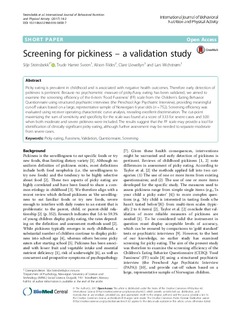| dc.contributor.author | Steinsbekk, Silje | |
| dc.contributor.author | Sveen, Trude Hamre | |
| dc.contributor.author | Fildes, Alison | |
| dc.contributor.author | Llewellyn, Clare | |
| dc.contributor.author | Wichstrøm, Lars | |
| dc.date.accessioned | 2017-12-13T13:42:06Z | |
| dc.date.available | 2017-12-13T13:42:06Z | |
| dc.date.created | 2017-01-09T15:05:57Z | |
| dc.date.issued | 2017 | |
| dc.identifier.citation | International Journal of Behavioral Nutrition and Physical Activity. 2017, 14 (2), 1-4. | nb_NO |
| dc.identifier.issn | 1479-5868 | |
| dc.identifier.uri | http://hdl.handle.net/11250/2471267 | |
| dc.description.abstract | Picky eating is prevalent in childhood and is associated with negative health outcomes. Therefore early detection of pickiness is pertinent. Because no psychometric measure of picky/fussy eating has been validated, we aimed to examine the screening efficiency of the 6-item ‘Food Fussiness’ (FF) scale from the Children’s Eating Behavior Questionnaire using structured psychiatric interviews (the Preschool Age Psychiatric Interview), providing meaningful cut-off values based on a large, representative sample of Norwegian 6 year olds (n = 752). Screening efficiency was evaluated using receiver operating characteristic curve analysis, revealing excellent discrimination. The cut-point maximizing the sum of sensitivity and specificity for the scale was found at a score of 3.33 for severe cases and 3.00 when both moderate and severe pickiness were included. The results suggest that the FF scale may provide a tool for identification of clinically significant picky eating, although further assessment may be needed to separate moderate from severe cases | nb_NO |
| dc.language.iso | eng | nb_NO |
| dc.publisher | BioMed Central | nb_NO |
| dc.rights | Navngivelse 4.0 Internasjonal | * |
| dc.rights.uri | http://creativecommons.org/licenses/by/4.0/deed.no | * |
| dc.title | Screening for pickiness – a validation study | nb_NO |
| dc.type | Journal article | nb_NO |
| dc.type | Peer reviewed | nb_NO |
| dc.description.version | publishedVersion | nb_NO |
| dc.source.pagenumber | 1-4 | nb_NO |
| dc.source.volume | 14 | nb_NO |
| dc.source.journal | International Journal of Behavioral Nutrition and Physical Activity | nb_NO |
| dc.source.issue | 2 | nb_NO |
| dc.identifier.doi | 10.1186/s12966-016-0458-7 | |
| dc.identifier.cristin | 1423580 | |
| dc.description.localcode | © The Author(s). 2017 Open Access. This article is distributed under the terms of the Creative Commons Attribution 4.0 International License (http://creativecommons.org/licenses/by/4.0/), which permits unrestricted use, distribution, and reproduction in any medium, provided you give appropriate credit to the original author(s) and the source, provide a link to the Creative Commons license, and indicate if changes were made. The Creative Commons Public Domain Dedication waiver (http://creativecommons.org/publicdomain/zero/1.0/) applies to the data made available in this article, unless otherwise stated. | nb_NO |
| cristin.unitcode | 194,67,40,0 | |
| cristin.unitname | Institutt for psykologi | |
| cristin.ispublished | true | |
| cristin.fulltext | original | |
| cristin.qualitycode | 2 | |

